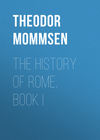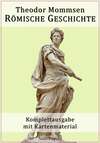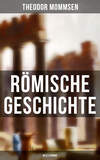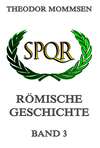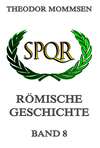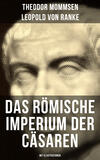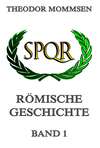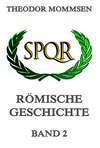Buch lesen: «The History of Rome, Book I», Seite 8
CHAPTER VI
The Non-Burgesses and the Reformed Constitution
Amalgamation of the Palatine and Quirinal Cities
The history of every nation, and of Italy more especially, is a —synoikismos— on a great scale. Rome, in the earliest form in which we have any knowledge of it, was already triune, and similar incorporations only ceased when the spirit of Roman vigour had wholly died away. Apart from that primitive process of amalgamation of the Ramnes, Titles, and Luceres, of which hardly anything beyond the bare fact is known, the earliest act of incorporation of this sort was that by which the Hill-burgesses became merged in the Palatine Rome. The organization of the two communities, when they were about to be amalgamated, may be conceived to have been substantially similar; and in solving the problem of union they would have to choose between the alternatives of retaining duplicate institutions or of abolishing one set of these and extending the other to the whole united community. They adopted the former course with respect to all sanctuaries and priesthoods. Thenceforth the Roman community had its two guilds of Salii and two of Luperci, and as it had two forms of Mars, it had also two priests for that divinity—the Palatine priest, who afterwards usually took the designation of priest of Mars, and the Colline, who was termed priest of Quirinus. It is likely, although it can no longer be proved, that all the old Latin priesthoods of Rome—the Augurs, Pontifices, Vestals, and Fetials—originated in the same way from a combination of the priestly colleges of the Palatine and Quirinal communities. In the division into local regions the town on the Quirinal hill was added as a fourth region to the three belonging to the Palatine city, viz. the Suburan, Palatine, and suburban (-Esquiliae-). In the case of the original —synoikismos— the annexed community was recognized after the union as at least a tribe (part) of the new burgess-body, and thus had in some sense a continued political existence; but this course was not followed in the case of the Hill-Romans or in any of the later processes of annexation. After the union the Roman community continued to be divided as formerly into three tribes, each containing ten wardships (-curiae-); and the Hill-Romans—whether they were or were not previously distributed into tribes of their own—must have been inserted into the existing tribes and wardships. This insertion was probably so arranged that, while each tribe and wardship received its assigned proportion of the new burgesses, the new burgesses in these divisions were not amalgamated completely with the old; the tribes henceforth presented two ranks: the Tities, Ramnes, and Luceres being respectively subdivided into first and second (-priores-, -posteriores-). With this division was connected in all probability that arrangement of the organic institutions of the community in pairs, which meets us everywhere. The three pairs of Sacred Virgins are expressly described as representatives of the three tribes with their first and second ranks; and it may be conjectured that the pair of Lares worshipped in each street had a similar origin. This arrangement is especially apparent in the army: after the union each half-tribe of the tripartite community furnished a hundred horsemen, and the Roman burgess cavalry was thus raised to six "hundreds," and the number of its captains probably from three to six. There is no tradition of any corresponding increase to the infantry; but to this origin we may refer the subsequent custom of calling out the legions regularly two by two, and this doubling of the levy probably led to the rule of having not three, as was perhaps originally the case, but six leaders-of-division to command the legion. It is certain that no corresponding increase of seats in the senate took place: on the contrary, the primitive number of three hundred senators remained the normal number down to the seventh century; with which it is quite compatible that a number of the more prominent men of the newly annexed community may have been received into the senate of the Palatine city. The same course was followed with the magistracies: a single king presided over the united community, and there was no change as to his principal deputies, particularly the warden of the city. It thus appears that the ritual institutions of the Hill-city were continued, and that the doubled burgess-body was required to furnish a military force of double the numerical strength; but in other respects the incorporation of the Quirinal city into the Palatine was really a subordination of the former to the latter. If we have rightly assumed that the contrast between the Palatine old and the Quirinal new burgesses was identical with the contrast between the first and second Tities, Ramnes, and Luceres, it was thus the -gentes-of the Quirinal city that formed the "second" or the "lesser." The distinction, however, was certainly more an honorary than a legal precedence. At the taking of the vote in the senate the senators taken from the old clans were asked before those of the "lesser." In like manner the Colline region ranked as inferior even to the suburban (Esquiline) region of the Palatine city; the priest of the Quirinal Mars as inferior to the priest of the Palatine Mars; the Quirinal Salii and Luperci as inferior to those of the Palatine. It thus appears that the —synoikismos—, by which the Palatine community incorporated that of the Quirinal, marked an intermediate stage between the earliest —synoikismos— by which the Tities, Ramnes, and Luceres became blended, and all those that took place afterwards. The annexed community was no longer allowed to form a separate tribe in the new whole, but it was permitted to furnish at least a distinct portion of each tribe; and its ritual institutions were not only allowed to subsist—as was afterwards done in other cases, after the capture of Alba for example—but were elevated into institutions of the united community, a course which was not pursued in any subsequent instance.
Dependents and Guests
This amalgamation of two substantially similar commonwealths produced rather an increase in the size than a change in the intrinsic character of the existing community. A second process of incorporation, which was carried out far more gradually and had far deeper effects, may be traced back, so far as the first steps in it are concerned, to this epoch; we refer to the amalgamation of the burgesses and the —metoeci—. At all times there existed side by side with the burgesses in the Roman community persons who were protected, the "listeners" (-clientes-), as they were called from their being dependents on the several burgess-households, or the "multitude" (-plebes-, from -pleo-, -plenus-), as they were termed negatively with reference to their want of political rights.41 The elements of this intermediate stage between the freeman and the slave were, as has been shown42 already in existence in the Roman household: but in the community this class necessarily acquired greater importance -de facto- and -de jure-, and that from two reasons. In the first place the community might itself possess half-free clients as well as slaves; especially after the conquest of a town and the breaking up of its commonwealth it might often appear to the conquering community advisable not to sell the mass of the burgesses formally as slaves, but to allow them the continued possession of freedom -de facto-, so that in the capacity as it were of freedmen of the community they entered into relations of clientship whether to the clans, or to the king. In the second place by means of the community and its power over the individual burgesses, there was given the possibility of protecting the clients against an abusive exercise of the -dominium- still subsisting in law. At an immemorially early period there was introduced into Roman law the principle on which rested the whole legal position of the —metoeci—, that, when a master on occasion of a public legal act—such as in the making of a testament, in an action at law, or in the census—expressly or tacitly surrendered his -dominium-, neither he himself nor his lawful successors should ever have power arbitrarily to recall that resignation or reassert a claim to the person of the freedman himself or of his descendants. The clients and their posterity did not by virtue of their position possess either the rights of burgesses or those of guests: for to constitute a burgess a formal bestowal of the privilege was requisite on the part of the community, while the relation of guest presumed the holding of burgess-rights in a community which had a treaty with Rome. What they did obtain was a legally protected possession of freedom, while they continued to be -de jure- non-free. Accordingly for a lengthened period their relations in all matters of property seem to have been, like those of slaves, regarded in law as relations of the patron, so that it was necessary that the latter should represent them in processes at law; in connection with which the patron might levy contributions from them in case of need, and call them to account before him criminally. By degrees, however, the body of —metoeci— outgrew these fetters; they began to acquire and to alienate in their own name, and to claim and obtain legal redress from the Roman burgess-tribunals without the formal intervention of their patron.
In matters of marriage and inheritance, equality of rights with the burgesses was far sooner conceded to foreigners43 than to those who were strictly non-free and belonged to no community; but the latter could not well be prohibited from contracting marriages in their own circle and from forming the legal relations arising out of marriage—those of marital and paternal power, of -agnatio- and -gentilitas- of heritage and of tutelage—after the model of the corresponding relations among the burgesses.
Similar consequences to some extent were produced by the exercise of the -ius hospitii-, in so far as by virtue of it foreigners settled permanently in Rome and established a domestic position there. In this respect the most liberal principles must have prevailed in Rome from primitive times. The Roman law knew no distinctions of quality in inheritance and no locking up of estates. It allowed on the one hand to every man capable of making a disposition the entirely unlimited disposal of his property during his lifetime; and on the other hand, so far as we know, to every one who was at all entitled to have dealings with Roman burgesses, even to the foreigner and the client, the unlimited right of acquiring moveable, and (from the time when immoveables could be held as private property at all) within certain limits also immoveable, estate in Rome. Rome was in fact a commercial city, which was indebted for the commencement of its importance to international commerce, and which with a noble liberality granted the privilege of settlement to every child of an unequal marriage, to every manumitted slave, and to every stranger who surrendering his rights in his native land emigrated to Rome.
Class of —Metoeci— Subsisting by the Side of the Community
At first, therefore, the burgesses were in reality the protectors, the non-burgesses were the protected; but in Rome as in all communities which freely admit settlement but do not throw open the rights of citizenship, it soon became a matter of increasing difficulty to harmonize this relation -de jure- with the actual state of things. The flourishing of commerce, the full equality of private rights guaranteed to all Latins by the Latin league (including even the acquisition of landed property), the greater frequency of manumissions as prosperity increased, necessarily occasioned even in peace a disproportionate increase of the number of —metoeci—. That number was further augmented by the greater part of the population of the neighbouring towns subdued by force of arms and incorporated with Rome; which, whether it removed to the city or remained in its old home now reduced to the rank of a village, ordinarily exchanged its native burgess-rights for those of a Roman —metoikos—. Moreover the burdens of war fell exclusively on the old burgesses and were constantly thinning the ranks of their patrician descendants, while the —metoeci— shared in the results of victory without having to pay for it with their blood.
Under such circumstances the only wonder is that the Roman patriciate did not disappear much more rapidly than it actually did. The fact of its still continuing for a prolonged period a numerous community can scarcely be accounted for by the bestowal of Roman burgess-rights on several distinguished foreign clans, which after emigrating from their homes or after the conquest of their cities received the Roman franchise—for such grants appear to have occurred but sparingly from the first, and to have become always the more rare as the franchise increased in value. A cause of greater influence, in all likelihood, was the introduction of the civil marriage, by which a child begotten of patrician parents living together as married persons, although without -confarreatio-, acquired full burgess-rights equally with the child of a -confarreatio- marriage. It is at least probable that the civil marriage, which already existed in Rome before the Twelve Tables but was certainly not an original institution, was introduced for the purpose of preventing the disappearance of the patriciate.44 To this connection belong also the measures which were already in the earliest times adopted with a view to maintain a numerous posterity in the several households.45
Nevertheless the number of the —metoeci— was of necessity constantly on the increase and liable to no diminution, while that of the burgesses was at the utmost perhaps not decreasing; and in consequence the —metoeci— necessarily acquired by imperceptible degrees another and a freer position. The non-burgesses were no longer merely emancipated slaves or strangers needing protection; their ranks included the former burgesses of the Latin communities vanquished in war, and more especially the Latin settlers who lived in Rome not by the favour of the king or of any other burgess, but by federal right. Legally unrestricted in the acquiring of property, they gained money and estate in their new home, and bequeathed, like the burgesses, their homesteads to their children and children's children. The vexatious relation of dependence on particular burgess-households became gradually relaxed. If the liberated slave or the immigrant stranger still held an entirely isolated position in the state, such was no longer the case with his children, still less with his grandchildren, and this very circumstance of itself rendered their relations to the patron of less moment. While in earlier times the client was exclusively left dependent for legal protection on the intervention of the patron, the more the state became consolidated and the importance of the clanships and households in consequence diminished, the more frequently must the individual client have obtained justice and redress of injury, even without the intervention of his patron, from the king. A great number of the non-burgesses, particularly the members of the dissolved Latin communities, had, as we have already said, probably from the outset not any place as clients of the royal or other great clans, and obeyed the king nearly in the same manner as did the burgesses. The king, whose sovereignty over the burgesses was in truth ultimately dependent on the good-will of those obeying, must have welcomed the means of forming out of his own -proteges- essentially dependent on him a body bound to him by closer ties.
Plebs
Thus there grew up by the side of the burgesses a second community in Rome: out of the clients arose the Plebs. This change of name is significant. In law there was no difference between the client and the plebeian, the "dependent" and the "man of the multitude;" but in fact there was a very important one, for the former term brought into prominence the relation of dependence on a member of the politically privileged class; the latter suggested merely the want of political rights. As the feeling of special dependence diminished, that of political inferiority forced itself on the thoughts of the free —metoeci—; and it was only the sovereignty of the king ruling equally over all that prevented the outbreak of political conflict between the privileged and the non-privileged classes.
The Servian Constitution
The first step, however, towards the amalgamation of the two portions of the people scarcely took place in the revolutionary way which their antagonism appeared to foreshadow. The reform of the constitution, which bears the name of king Servius Tullius, is indeed, as to its historical origin, involved in the same darkness with all the events of a period respecting which we learn whatever we know not by means of historical tradition, but solely by means of inference from the institutions of later times. But its character testifies that it cannot have been a change demanded by the plebeians, for the new constitution assigned to them duties alone, and not rights. It must rather have owed its origin either to the wisdom of one of the Roman kings, or to the urgency of the burgesses that they should be delivered from exclusive liability to burdens, and that the non-burgesses should be made to share on the one hand in taxation—that is, in the obligation to make advances to the state (the -tributum-)—and rendering task-work, and on the other hand in the levy. Both were comprehended in the Servian constitution, but they hardly took place at the same time. The bringing in of the non-burgesses presumably arose out of the economic burdens; these were early extended to such as were "possessed of means" (-locupletes-) or "settled people" (-adsidui-, freeholders), and only those wholly without means, the "children-producers" (-proletarii-, -capite censi-) remained free from them. Thereupon followed the politically more important step of bringing in the non-burgesses to military duty. This was thenceforth laid not upon the burgesses as such, but upon the possessors of land, the -tribules-, whether they might be burgesses or mere —metoeci—; service in the army was changed from a personal burden into a burden on property. The details of the arrangement were as follow.
The Five Classes
Every freeholder from the eighteenth to the sixtieth year of his age, including children in the household of freeholder fathers, without distinction of birth, was under obligation of service, so that even the manumitted slave had to serve, if in an exceptional case he had come into possession of landed property. The Latins also possessing land—others from without were not allowed to acquire Roman soil—were called in to service, so far as they had, as was beyond doubt the case with most of them, taken up their abode on Roman territory. The body of men liable to serve was distributed, according to the size of their portions of land, into those bound to full service or the possessors of a full hide,46 who were obliged to appear in complete armour and in so far formed pre-eminently the war army (-classis-), and the four following ranks of smaller landholders—the possessors respectively of three fourths, of a half, of a quarter, or of an eighth of a whole farm—from whom was required fulfilment of service, but not equipment in complete armour, and they thus had a position below the full rate (-infra classem-). As the land happened to be at that time apportioned, almost the half of the farms were full hides, while each of the classes possessing respectively three-fourths, the half, and the quarter of a hide, amounted to scarcely an eighth of the freeholders, and those again holding an eighth of a hide amounted to fully an eighth. It was accordingly laid down as a rule that in the case of the infantry the levy should be in the proportion of eighty holders of a full hide, twenty from each of the three next ranks, and twenty-eight from the last.
Cavalry
The cavalry was similarly dealt with. The number of divisions in it was tripled, and the only difference in this case was that the six divisions already existing with the old names (-Tities-, -Ramnes-, -Luceres- -primi- and -secundi-) were left to the patricians, while the twelve new divisions were formed chiefly from the non-burgesses. The reason for this difference is probably to be sought in the fact that at that period the infantry were formed anew for each campaign and discharged on their return home, whereas the cavalry with their horses were on military grounds kept together also in time of peace, and held their regular drills, which continued to subsist as festivals of the Roman equites down to the latest times.47 Accordingly the squadrons once constituted were allowed, even under this reform, to keep their ancient names. In order to make the cavalry accessible to every burgess, the unmarried women and orphans under age, so far as they had possession of land, were bound instead of personal service to provide the horses for particular troopers (each trooper had two of them), and to furnish them with fodder. On the whole there was one horseman to nine foot-soldiers; but in actual service the horsemen were used more sparingly.
The non-freeholders (-adcensi-, people standing at the side of the list of those owing military service) had to supply the army with workmen and musicians as well as with a number of substitutes who marched with the army unarmed (-velati-), and, when vacancies occurred in the field, took their places in the ranks equipped with the weapons of the sick or of the fallen.
Levy-Districts
To facilitate the levying of the infantry, the city was distributed into four "parts" (-tribus-); by which the old triple division was superseded, at least so far as concerned its local significance. These were the Palatine, which comprehended the height of that name along with the Velia; the Suburan, to which the street so named, the Carinae, and the Caelian belonged; the Esquiline; and the Colline, formed by the Quirinal and Viminal, the "hills" as contrasted with the "mounts" of the Capitol and Palatine. We have already spoken of the formation of these regions48 and shown how they originated out of the ancient double city of the Palatine and the Quirinal. By what process it came to pass that every freeholder burgess belonged to one of those city-districts, we cannot tell; but this was now the case; and that the four regions were nearly on an equality in point of numbers, is evident from their being equally drawn upon in the levy. This division, which had primary reference to the soil alone and applied only inferentially to those who possessed it, was merely for administrative purposes, and in particular never had any religious significance attached to it; for the fact that in each of the city-districts there were six chapels of the enigmatical Argei no more confers upon them the character of ritual districts than the erection of an altar to the Lares in each street implies such a character in the streets.
Each of these four levy-districts had to furnish approximately the fourth part not only of the force as a whole, but of each of its military subdivisions, so that each legion and each century numbered an equal proportion of conscripts from each region, in order to merge all distinctions of a gentile and local nature in the one common levy of the community and, especially through the powerful levelling influence of the military spirit, to blend the —metoeci— and the burgesses into one people.
Organization of the Army
In a military point of view, the male population capable of bearing arms was divided into a first and second levy, the former of which, the "juniors" from the commencement of the eighteenth to the completion of the forty-sixth year, were especially employed for service in the field, while the "seniors" guarded the walls at home. The military unit came to be in the infantry the now doubled legion49—a phalanx, arranged and armed completely in the old Doric style, of 6000 men who, six file deep, formed a front of 1000 heavy-armed soldiers; to which were attached 2400 "unarmed".50 The four first ranks of the phalanx, the -classis-, were formed by the fully-armed hoplites of those possessing a full hide; in the fifth and sixth were placed the less completely equipped farmers of the second and third division; the two last divisions were annexed as rear ranks to the phalanx or fought by its side as light-armed troops. Provision was made for readily supplying the accidental gaps which were so injurious to the phalanx. Thus there served in it 84 centuries or 8400 men, of whom 6000 were hoplites, 4000 of the first division, 1000 from each of the two following, and 2400 light-armed, of whom 1000 belonged to the fourth, and 1200 to the fifth division; approximately each levy-district furnished to the phalanx 2100, and to each century 25 men. This phalanx was the army destined for the field, while a like force of troops was reckoned for the seniors who remained behind to defend the city. In this way the normal amount of the infantry came to 16,800 men, 80 centuries of the first division, 20 from each of the three following, and 28 from the last division—not taking into account the two centuries of substitutes or those of the workmen or the musicians. To all these fell to be added the cavalry, which consisted of 1800 horse; often when the army took the field, however, only the third part of the whole number was attached to it. The normal amount of the Roman army of the first and second levy rose accordingly to close upon 20,000 men: which number must beyond doubt have corresponded on the whole to the effective strength of the Roman population capable of arms, as it stood at the time when this new organization was introduced. As the population increased the number of centuries was not augmented, but the several divisions were strengthened by persons added, without altogether losing sight, however, of the fundamental number. Indeed the Roman corporations in general, closed as to numbers, very frequently evaded the limit imposed upon them by admitting supernumerary members.
Census
This new organization of the army was accompanied by a more careful supervision of landed property on the part of the state. It was now either ordained for the first time or, if not, at any rate defined more carefully, that a land-register should be established, in which the several proprietors of land should have their fields with all their appurtenances, servitudes, slaves, beasts of draught and of burden, duly recorded. Every act of alienation, which did not take place publicly and before witnesses, was declared null; and a revision of the register of landed property, which was at the same time the levy-roll, was directed to be made every fourth year. The -mancipatio- and the -census- thus arose out of the Servian military organization.
Political Effects of the Servian Military Organization
It is evident at a glance that this whole institution was from the outset of a military nature. In the whole detailed scheme we do not encounter a single feature suggestive of any destination of the centuries to other than purely military purposes; and this alone must, with every one accustomed to consider such matters, form a sufficient reason for pronouncing its application to political objects a later innovation. If, as is probable, in the earliest period every one who had passed his sixtieth year was excluded from the centuries, this has no meaning, so far as they were intended from the first to form a representation of the burgess-community similar to and parallel with the curies. Although, however, the organization of the centuries was introduced merely to enlarge the military resources of the burgesses by the inclusion of the —metoeci— and, in so far, there is no greater error than to exhibit the Servian organization as the introduction of a timocracy in Rome—yet the new obligation imposed upon the inhabitants to bear arms exercised in its consequences a material influence on their political position. He who is obliged to become a soldier must also, so long as the state is not rotten, have it in his power to become an officer; beyond question plebeians also could now be nominated in Rome as centurions and as military tribunes. Although, moreover, the institution of the centuries was not intended to curtail the political privileges exclusively possessed by the burgesses as hitherto represented in the curies, yet it was inevitable that those rights, which the burgesses hitherto had exercised not as the assembly of curies, but as the burgess-levy, should pass over to the new centuries of burgesses and —metoeci—. Henceforward, accordingly, it was the centuries whose consent the king had to ask before beginning an aggressive war.51 It is important, on account of the subsequent course of development, to note these first steps towards the centuries taking part in public affairs; but the centuries came to acquire such rights at first more in the way of natural sequence than of direct design, and subsequently to the Servian reform, as before, the assembly of the curies was regarded as the proper burgess-community, whose homage bound the whole people in allegiance to the king. By the side of these new landowning full-burgesses stood the domiciled foreigners from the allied Latium, as participating in the public burdens, tribute and task-works (hence -municipes-); while the burgesses not domiciled, who were beyond the pale of the tribes, and had not the right to serve in war and vote, came into view only as "owing tribute" (-aerarii-).
In this way, while hitherto there had been distinguished only two classes of members of the community, burgesses and clients, there were now established those three political classes, which exercised a dominant influence over the constitutional law of Rome for many centuries.
